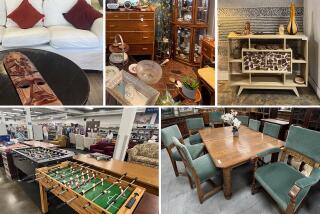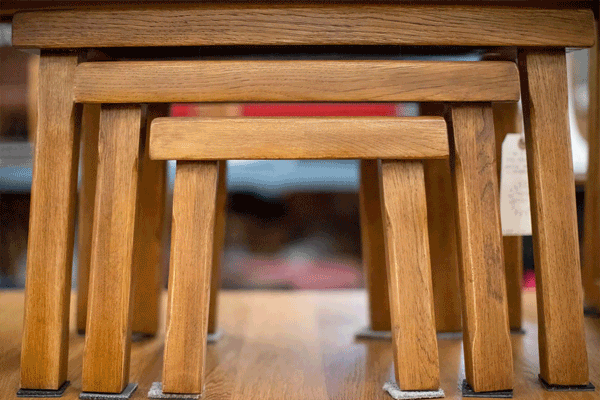Consignment bounces back
- Share via
The bidding was fast. Inside a packed showroom at Bonhams & Butterfields, auctioneer Carolyn Mani was moving quickly through lots of antique furniture, clocks and artwork. Images of the items flashed on overhead screens as Mani solicited bids, selling most items in less than a minute and often under their preauction estimates. A Japanese elm chest sold for $397. Six Louis XV chairs barely fetched $300 apiece, and a George III mahogany side table -- appraised at $500 to $700 -- hammered at $305.
In the world of used home furnishings, bargains are the order of the day. And one old idea that’s gaining new prominence in the secondhand market: consignment.
Mani’s Sunset Estate Auction at Bonhams is essentially a high-end consignment store that happens to open just once a month and use an auction to sell its wares. Across Southern California, however, other forms of consignment are becoming newly popular as buyers and sellers seek alternative ways to survive a bad economy.
No matter what you need or want -- vintage pianos, affordable baby furniture or midcentury collectibles -- it’s a market that’s thriving like few others.
“Since October of last year, I’ve seen an increase in the number of buyers looking for a great value,” said Mani, director of the Sunset Estate Auction. “I’m also getting a huge increase in the amount of calls from people who want to sell property. The majority of people are looking to sell things of value if they have hit the wall with cash flow.”
Throughout that Sunday afternoon, bidders would walk away with bargain after bargain. The hammer came down at $200 for a beautifully worn leather Art Deco chair, at $325 for an intricately detailed English oak desk, and at $150 for a petite tea table. In an hour, nearly 100 lots were sold at prices that often were below their auction estimates.
Though the term “consignment” often conjures images of resale shops selling women’s clothing, it’s an attractive option to sell big-ticket items such as furniture. The consignors own their property until it’s sold, so the consignment store needn’t tie up cash in inventory -- a plus for credit-strapped retailers finding it difficult to keep aisles stocked with merchandise. Sellers also retain their privacy, gain access to sophisticated shoppers and, if all goes well, earn higher profit than if they tried to unload the goods themselves.
The consignment procedure is similar whether you deal with an esteemed auctioneer or your corner resale store: You sign contracts that specify how buyer and seller will split the proceeds, how the final purchase price will be calculated and how unsold items will be handled.
The proceeds can be split any number of ways -- 50/50, 38/62, perhaps a sliding scale that changes according to the purchase price. Some consignment stores define the length of a contract and the conditions under which an item may be discounted.
Consignment furniture stores used to be more common in Los Angeles, where several were clustered among the antique stores and vintage boutiques on La Brea Avenue. Now only a few antique stores take on consigned items, usually as a favor to a needy customer, and only then if the item is special. Many of the region’s larger consignment stores -- including the Home Consignment Center in Foothill Ranch, Laguna Niguel, Yorba Linda and Irvine, and the Consignment Warehouse in Westlake Village -- are located in upscale suburbs that fulfill the business model’s call for newer homes, well-heeled clients and lower rents on large commercial buildings.
Palm Springs has long been a mecca for vintage furniture, culled from the many second homes and retirees’ estates in the resort community. The recession has changed the customers whom Sharon Dean sees at Estate Sale Co., the 21-year-old consignment furniture shop she co-owns in Palm Springs.
“I walked out into our parking lot the other day and saw three cars -- the first was a Bentley, and the next two were Jaguars,” she said. “It’s not poor people who shop consignment; it’s people who realize that retail maybe isn’t the way to go.”
Her 75,000-square-foot operation recently has been flooded by furniture from model homes and foreclosures. Prices are low enough that customers have snapped up half of her inventory every month, she said.
According to the National Assn. of Resale & Thrift Shops, stores that specialize in furniture make up one of the fastest-growing segments of the resale industry. Though the association doesn’t track statistics on consignment apart from resale, all segments have seen a 31% rise in year-over-year sales. A third of the surveyed members said the quality of this year’s new inventory was higher, too.
“There is a boom in every segment of this industry,” said Adele Meyer, executive director of the trade association.
At his 15 Home Consignment Center stores in California, Nevada and Texas, co-owner Johnny Crowell estimates that an unprecedented 60% of his inventory is new or almost new. It comes from model homes, factory closeouts and furniture stores that are liquidating. Although business is bad for others, his stores are doing well.
“The typical store sells about 2,000 pieces every 30 days. Half of the product goes in the first two weeks,” Crowell said. “That’s the secret to surviving in this business -- price it so it goes quickly.”
Discounts are significant for shoppers, who can expect to pay at least 50% to 75% less than the retail price. A $400 table might cost $100 to $150 at his stores. Now that more new furniture is in the mix, Crowell can suspend his “no upholstered items” policy and consumers can buy a new $2,500 leather couch for $700 to $800.
“The average piece of furniture sells today for about half of what it sold for last year,” he said. “If you have money, this is probably the best time ever to buy furniture.”
Though Bonhams typically deals with previously owned items, the auction house staged a July sale of new merchandise from high-end furniture maker Burton-Ching. The San Francisco-based manufacturer of 18th century antique reproductions recently consolidated its showrooms and contracted with Bonhams to dispense with the overflow.
“The estimates are anywhere from 50 to 80% less than the showroom cost,” said Jeffrey Smith, Bonhams’ North American director of furniture and decorative arts.
The group’s starring piece, a George I-style red-and-gold lacquered bookcase, sold for $6,710, far less than the $25,000 to $30,000 original retail price.
Some fancy family heirlooms are now getting a cold, hard reappraisal by their inheritors. Ornate European furniture fills the two floors of the Eclectics Auction House, a large consignment and auction house that opened this spring across from the Beverly Center. Auctioneer Melissa Taraneh said many of her consignors have fallen on hard times.
“A lot of people are doing whatever they can to find ways to turn things into money,” she said.
Consignment stores also offer manufacturers and their wholesalers a less conspicuous way to liquidate furniture that might otherwise compete with their retail accounts. That’s partly why the inventory at the Consignment Warehouse in Westlake Village is filling with new furniture from stores and showrooms that are shutting down and consolidating, store founder Mike Pegler said.
It is with some despair that he describes how he’s also more frequently helping private sellers salvage value from the furnishings of their foreclosed homes or raise cash from a family heirloom. He sees his store as providing a service to those sellers.
“Often, this is a way to make people feel better about letting it go,” Pegler said. “It’s being shopped by a clientele that recognizes a bargain and the quality. The sellers know that they will get decent money for it. But they really want it to be appreciated and go into a home that’s worthy.
“To a lot of people, that’s almost more important than the money.”
--
More to Read
Inside the business of entertainment
The Wide Shot brings you news, analysis and insights on everything from streaming wars to production — and what it all means for the future.
You may occasionally receive promotional content from the Los Angeles Times.










